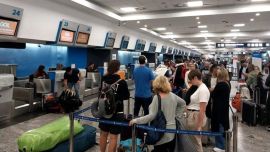“Submarines don’t fly. It’s in the sea. It’s there. Or if it isn’t, something happened. You have to see both sides” – Marta Vallejos.
On November 15, the TR-1700 class Argentine submarine ARA San Juan disappeared returning to its base in Mar del Plata from a routine military exercise in the southern port of Ushuaia.
Its last transmission was at 7.30am that very morning. Its commander, Pedro Martín Fernández, reported that a short circuit in the submarine’s batteries had caused a small fire on board, but that the crew were well. After being ordered to return to base, the line fell silent.
Two days later, the news broke. Suddenly, Argentina was immersed in the search for the 44 missing crew-members, accompanying the desperate families, following every detail and counting down the days that the crew could allegedly survive on the oxygen in the vessel.
International support flooded in. Thirteen countries participated in a frantic search for the San Juan and its crew, with over 4,000 personnel probing over 500,000 square kilometres of the South Atlantic. All hope seemed to be lost.
But then came the news that the Comprehensive Nuclear Test-Ban Treaty Organisation had detected a “hydro-acoustic anomaly” consistent with an explosion two hours after that last transmission, just 30 nautical miles north. This, according to the Navy and experts, could have been the sound of the submarine imploding.
The search for the crew-members was called off at the start of December. But for the family members, this marked only a painful beginning.
A YEAR ON
“A year on from the disappearance, we feel very sad, very disappointed. Personally, I am very frustrated because we have no answers. We have more questions and no answers. We haven’t been able to find them, we don’t know where they are, we don’t know what happened,” says Luis Tagliapietra, speaking to the Times.
He lost his eldest son, 27-year-old Second-Lieutenant Alejandro Damián, in the tragedy. As a lawyer, Tagliapietra immediately put himself forward as a plaintiff in a judicial investigation and became the most vocal public figure of the 44 families.
After a whirlwind few months of back-to-back interviews and court appearances, in September Tagliapietra went aboard the Seabed Constructor, the vessel from the US firm Ocean Infinity that is conducting the search for the vessel. Tagliapietra is an observer of the underwater search, with gruelling hours and minimal contact with the mainland. Being on in the high seas, his interview was achieved solely through WhatsApp voice messaging.
Marta Vallejos hasn’t heard from her 38-year-old brother, Celso Oscar Vallejos, since that tragic day. As with Tagliapietra, the ARA San Juan has never been far from her mind over these past 12 months. While she advocates and is carrying out her own investigation into what happened, she travels constantly between her home in Buenos Aires to Mar del Plata: her family is based there, supporting her sister-in-law and three children.
In December, after a dream, she fasted for 40 days as an offering to God for the miracle that she, her family and the others desperately hoped for. “Honestly, I can’t believe it. I see his photos, I have many memories because we were so close, we shared kindergarten, primary school, high school, the same friends [...] Personally, my life stopped on that 15th of November 2017 and I’m still at a standstill. I still think, ‘Where are they? What happened?’” she says.
INVESTIGATIONS
“We feel very alone when faced with the powers of the state,” says Tagliapietra.
Over the past year, multiple investigations have been opened to establish the causes of the ARA San Juan’s disappearance, and to attribute blame. As well as the aforementioned criminal investigation running via the Judicial branch, there is also an independent commission comprised of three submarine experts set up by the Executive branch and finally, a Bicameral Commission in the Legislative Branch.
The judicial investigation is centred in the Patagonian port of Caleta Olivia, with federal judge Marta Yañez at the head. Although proceedings haven’t been questionable, they have been extremely and, as a result, painfully drawn out.
Despite its rigour, Tagliapietra has no illusions about the judicial investigation in which he is a plaintiff.
“The file is still categorised as ‘gathering evidence.’ There’s been an innumerable amount of testimony and a lot of papers have been gathered but there’s absolutely nothing,” he says. “No efficient measures have been taken to give the investigation a concrete direction, toward the truth.”
While Tagliapietra commended the creation and the actions of the Bicameral Commission, he also alluded to certain lawmakers actively blocking helpful legislation. Ultimately, he points out that “neither chamber has created a single law that guarantees the continuation of this search nor the investigation of the truth nor concrete backing or support.”
When it comes to the Executive branch, however, the intensity of the criticism increases: on the one hand, toward the Defence Ministry and the Navy and on the other, President Mauricio Macri.
“[Defence Minister Oscar Aguad’s] incompetence is more of a criminal attitude in many ways because of how badly things have been done, sometimes seemingly on purpose,” says Tagliapietra. “And in the middle of it all, we’ve had to deal with people trying to impose their hypotheses, particularly the Defence Ministry, with this idea that it was all [the crew’s] fault.”
This claim is based on a report that the Navy is set to publish this week, which establishes that an “operational error” regarding an internal ventilation valve called the “Eco-19,” which may have led to water entering the submarine battery, which also may in turn not have been closed properly, and led to a short-circuit.
The report is being written out by the Accident Board, which includes retired captain Jorge Bergallo on its team of submarine experts, who lost his son, Lieutenant-Commander of the San Juan Jorge Ignacio Bergallo.
CRITICISM
The Navy has faced fierce criticism over its role in the San Juan’s disappearance, from alleged negligence regarding the state of the submarine itself to delaying the initial search by not reporting its disappearance and its confusing communications in the aftermath, which often contradicted with government statements. The government sacked the Navy Chief Admiral Marcelo Srur in December, 2017.
As for the government in general, Tagliapietra describes it as having been “alarmingly passive, especially the president,” pointing out that bar the anniversary ceremony, the last time Macri alluded to the ARA San Juan was on March 1, when he opened Congress. Tagliapietra accuses the president of “avoiding the issue” ever since.
Marta agrees. “The only person that has the power to decide, to make a radical change in this story and give closure to us as families and to the 44 million Argentines that still don’t know what happened, is the president of our nation,” she said.
In fact, a letter signed by “the majority of the family members” this week publicly rejected Macri’s presence at the ceremony of the anniversary of the San Juan’s disappearance, calling for his accountability as the ultimate head of the Armed Forces. Tagliapietra did not comment but Vallejos said that she did not agree with the move because it would not lead to dialogue.
“We only feel accompanied by the people [of Argentina] on the streets and on social media, which is very meaningful but, well, it’s not enough. It’s not enough,” laments Tagliapietra.
ON/OFF SEARCH
In September, the government hired Ocean Infinity to continue the search, an undersea mapping firm based in Texas. It deployed the Seabed Constructor (the research vessel that Tagliapietra is on) and five autonomous underwater vehicles (AUVs).
The contract it signed with the government for the search was for 60 days, with a US$7.5-million reward due only if the company found the submarine. Ocean Infinity is a newcomer in underwater exploration yet it also has experience: it took on a government contract with Malaysia this year to search for the missing Malaysian Airlines Flight 370 (which went missing in 2014) on the same no-find, no-fee basis, with a very short deadline.
“From day zero, I knew they wouldn’t find anything. They don’t have a Plan B to the area that’s already been searched by so many countries, where the last transmission came from. They didn’t bother to question it and carry out their own investigation or search the submarine’s trajectory from Ushuaia,” said Marta. “Their priorities are monetary and that [no-find, no-fee] contract means that they are not motivated to find it.”
Last week, the firm announced that they would halt the search until February, sparking immediate anger and, according to military sources who spoke with Infobae, they are set to head onto Brazil on another venture. Pressure from the Navy forced the firm to backtrack and comply with their original offer of a 60-day search. They have conceded to search an area requested by family members, based on testimony from May contending that noises, believed to be “banging” against the hull, were heard there.
Marta herself does not believe that this will amount to anything, as “[she] believe[s] it’s more likely to be further south.” Subsequently, it was reported that damage to the Seabed Constructor would force the suspension of the search, while repairs were made in South Africa.
In a statement to the Times, an Ocean Infinity spokesperson alluded to the upcoming completion of the contractual 60 days and said “[they] remain keen to support,” having requested a contract extension to return in February “if, following the further analysis that needs to now happen, there are sufficient grounds to do so.”
The firm also said that its “thoughts are with those affected by the tragedy and we have always in part been motivated by trying to help provide them with answers.”
FAITH
“I am never giving up until they find my brother [and] I know he would have done the same for me. My faith keeps me on my feet and gives me strength: I believe there is a God, and He has his own time. I don’t know when, but I have faith that they will find them,” says Marta.
Many families remain in Mar del Plata, where the 44 crew-members were supposed to return. Over the past year, there have been differences of opinion among the relatives but above all, they have shown a sense of unity and tremendous strength in continually advocating for their lost loved ones together. Marta describes how her own family, as well as her faith, has kept her strong: they all believe that Celso will return.
“Then there’s the strength that my nieces and nephew give me. They are the motor force for my sisters and my parents and me: we see them and we have to keep fighting,” said Marta of Celso’s three children: 12-year-old Sofía, eight-year-old Guadalupe and two-year-old Thiago.
The memories of their loved ones have not faded, even as the families fight each day to keep the search alive. They receive continual support from Argentina and beyond: every day, people on social media give their opinions as to where the vessel could be and tributes across the country are shared, from videos to a mural in Mendoza with the words “We have new heroes.”
“The last time I saw him, as always, we hugged and he gave me a kiss and said, ‘Love you, sis, see you when I get back.’ And that’s stayed with me,” Marta remembers. “I want the world to remember his smile.” “[I hope] that people have faith. That they pray as much as possible. That we may be united as a country, as a world [...] to close this chapter, so that they [the 44] may be in peace, and the families as well.”


























Comments